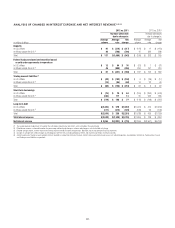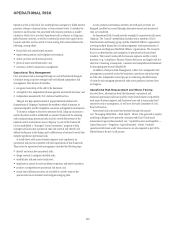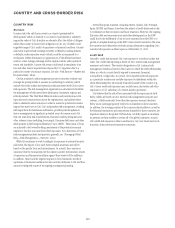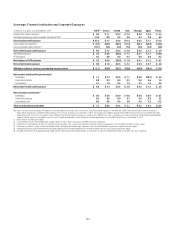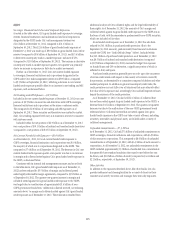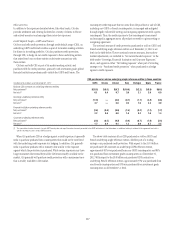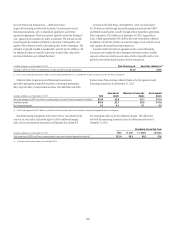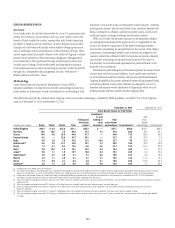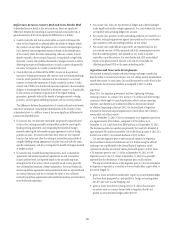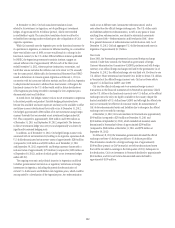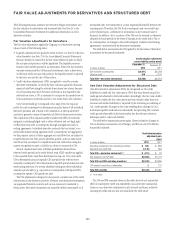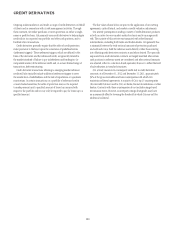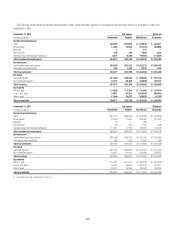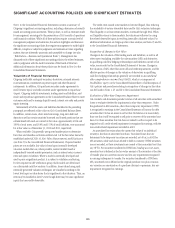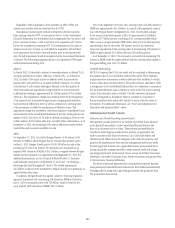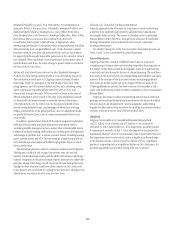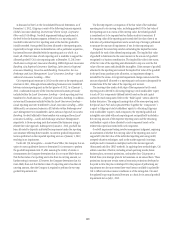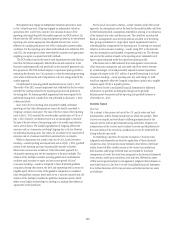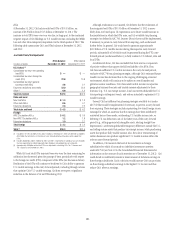Citibank 2012 Annual Report Download - page 143
Download and view the complete annual report
Please find page 143 of the 2012 Citibank annual report below. You can navigate through the pages in the report by either clicking on the pages listed below, or by using the keyword search tool below to find specific information within the annual report.121
Differences Between Country Risk and Cross-Border Risk
As described in more detail in the sections above, there are significant
differences between the reporting of country risk and cross-border risk. A
general summary of the more significant differences is as follows:
• Country risk is the risk that an event within a country will impair the
value of Citi’s franchise or adversely affect the ability of obligors within
the country to honor their obligations to Citi. Country risk reporting in
Citi’s internal risk management systems is based on the identification
of the country where the client relationship, taken as a whole, is most
directly exposed to the economic, financial, sociopolitical or legal risks.
Generally, country risk includes the benefit of margin received as well as
offsetting exposures and hedge positions. As such, country risk generally
measures net exposure to a credit or market risk event.
• Cross-border risk, as defined by the FFIEC, focuses on the potential
exposure if foreign governments take actions, such as enacting exchange
controls, which prevent the conversion of local currency to non-local
currency or restrict the remittance of funds outside the country. Unlike
country risk, FFIEC cross-border risk measures exposure to the immediate
obligors or counterparties domiciled in the given country or, if applicable,
by the location of collateral or guarantors of the legally binding
guarantees, generally without the benefit of margin received or hedge
positions, and recognizes offsetting exposures only for certain products.
The differences between the presentation of country risk and cross-border
risk can be substantial, including the identification of the country of risk,
as described above. In addition, some of the more significant differences by
product are described below:
• Forcountryrisk,netderivativereceivablesaregenerallyreportedbased
on fair value, netting receivables and payables under the same legally
binding netting agreement, and recognizing the benefit of margin
received under legally enforceable margin agreements and any hedge
positions in place. For cross-border risk, these items are also reported
based on fair value and allow for netting of receivables and payables if
a legally binding netting agreement is in place, but only with the same
specific counterparty, and do not recognize the benefit of margin received
or hedges in place.
• For country risk, secured financing transactions, such as repurchase
agreements and reverse repurchase agreements, as well as securities
loaned and borrowed, are reported based on the net credit exposure
arising from the transaction, which is typically small or zero given the
over-collateralized structure of these transactions. For cross-border risk,
reverse repurchase agreements and securities borrowed are reported based
on notional amounts and do not include the value of any collateral
received (repurchase agreements and securities loaned are not included in
cross-border risk reporting).
• For country risk, loans are reported net of hedges and collateral pledged
under legally enforceable margin agreements. For cross-border risk, loans
are reported without taking hedges into account.
• For country risk, securities in AFS and trading portfolios are reported on a
net basis, netting long positions against short positions. For cross-border
risk, securities in AFS and trading portfolios are not netted.
• For country risk, credit default swaps (CDS) are reported based on the
net notional amount of CDS purchased and sold, assuming zero recovery
from the underlying entity, and adjusted for any mark-to-market
receivable or payable position. For cross-border risk, CDS are included
based on the gross notional amount sold, and do not include any
offsetting purchased CDS on the same underlying entity.
Argentina and Venezuela Developments
Citi operates in several countries with strict foreign exchange controls that
limit its ability to convert local currency into U.S. dollars and/or transfer funds
outside the country. In such cases, Citi could be exposed to a risk of loss in the
event that the local currency devalues as compared to the U.S. dollar.
Argentina
Since 2011, the Argentine government has been tightening its foreign
exchange controls. As a result, Citi’s access to U.S. dollars and other foreign
currencies, which apply to capital repatriation efforts, certain operating
expenses, and discretionary investments offshore, has become limited.
In addition, beginning in January 2012, the Central Bank of Argentina
increased its minimum capital requirements, which affects Citi’s ability to
remit profits out of the country.
As of December 31, 2012, Citi’s net investment in its Argentine operations
was approximately $740 million, compared to $740 million as of
December 31, 2011 and down from $800 million as of September 30, 2012.
The decrease quarter-over-quarter was primarily the result of a dividend of
approximately $65 million received by Citi in the fourth quarter of 2012. For
the full year of 2012, Citi received dividends of $125 million.
Citi uses the Argentine peso as the functional currency in Argentina
and translates its financial statements into U.S. dollars using the official
exchange rate as published by the Central Bank of Argentina, which
continued to devalue its currency during the fourth quarter of 2012, from
4.70 Argentine pesos to one U.S. dollar at September 30, 2012 to 4.90
Argentine pesos to one U.S. dollar at December 31, 2012. It is generally
expected that the devaluation of the Argentine peso could continue.
The impact of devaluations of the Argentine peso on Citi’s net investment
in Argentina is reported as a translation loss in stockholders’ equity offset, to
the extent hedged, by:
• gains or losses recorded in stockholders’ equity on net investment hedges
that have been designated as, and qualify for, hedge accounting under
ASC 815 Derivatives and Hedging; and
• gainsorlossesrecordedinearningsforitsU.S.dollardenominated
monetary assets or currency futures held in Argentina that do not
qualify as net investment hedges under ASC 815.


